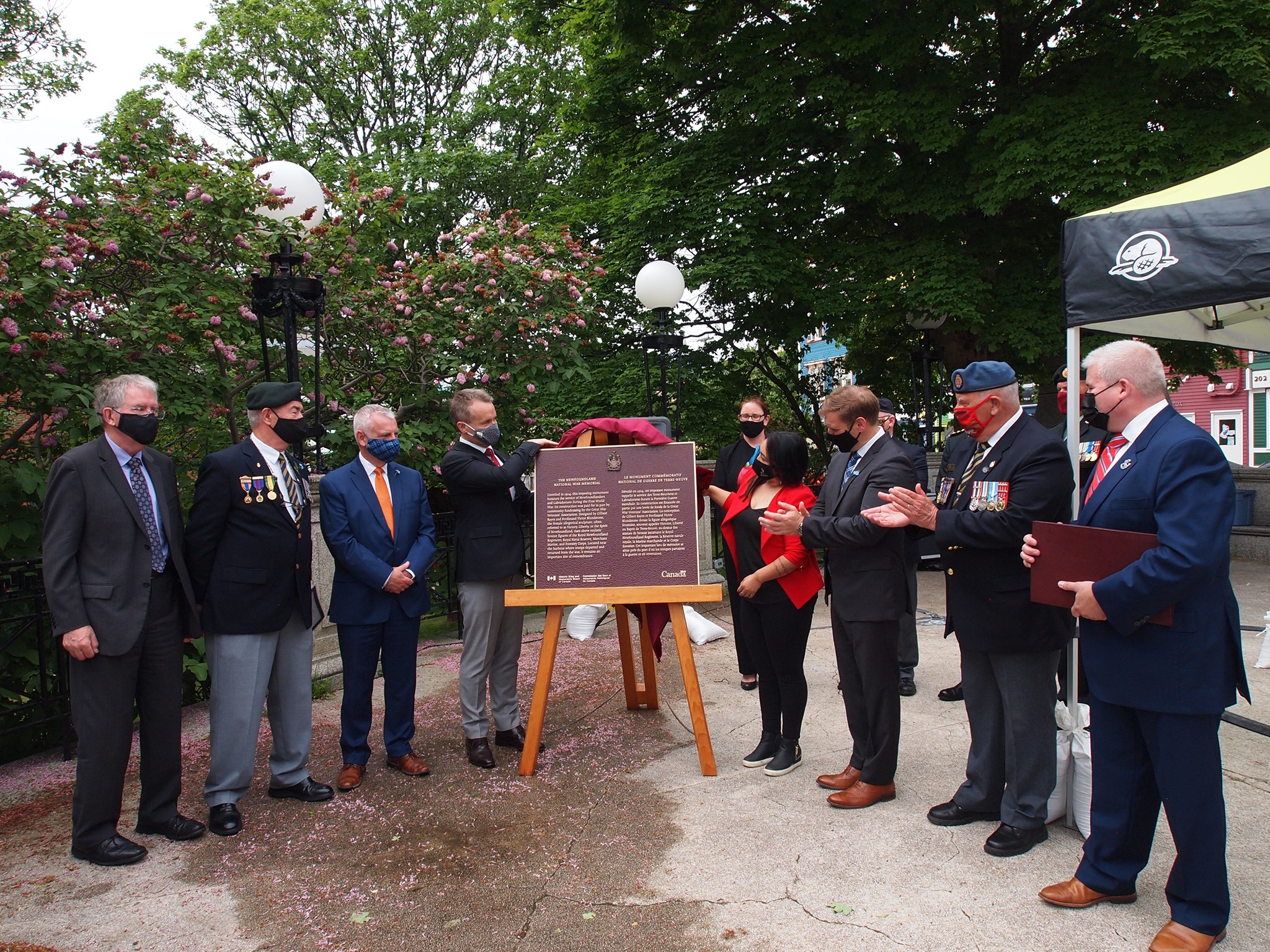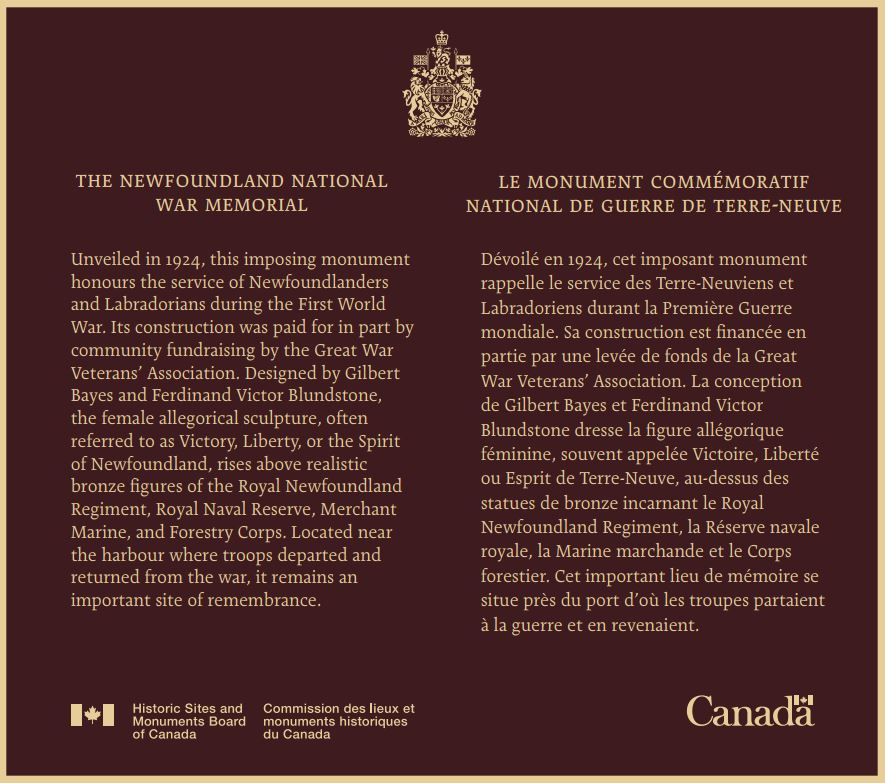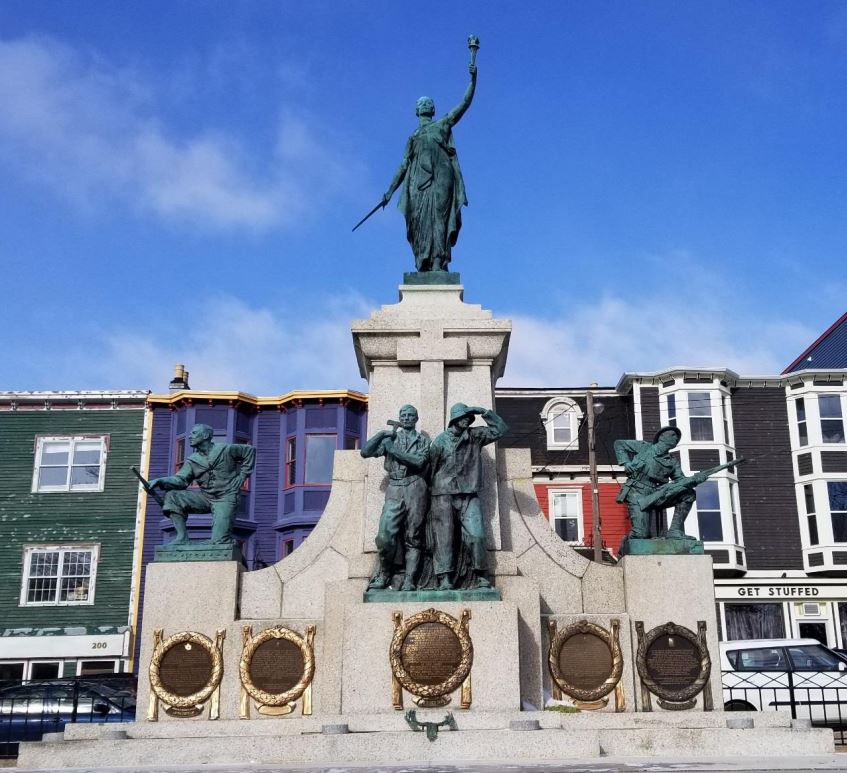Newfoundland National War Memorial National Historic Site
The Newfoundland National War Memorial was designated a national historic site in 2019.
Commemorative plaque: 85 Water Street , St. John's, Newfoundland and LabradorFootnote 1
Unveiled in 1924, this imposing monument honours the service of Newfoundlanders and Labradorians during the First World War. Its construction was paid for in part by community fundraising by the Great War Veterans’ Association. Designed by Gilbert Bayes and Ferdinand Victor Blundstone, the female allegorical sculpture, often referred to as Victory, Liberty, or the Spirit of Newfoundland, rises above realistic bronze figures of the Royal Newfoundland Regiment, Royal Naval Reserve, Merchant Marine, and Forestry Corps. Located near the harbour where troops departed and returned from the war, it remains an important site of remembrance.
The Newfoundland National War Memorial
Unveiled in 1924 to commemorate the Dominion of Newfoundland’s contributions to the First World War, the Newfoundland National War Memorial is an imposing monument featuring a rare combination of allegorical and realistic bronze sculptures designed by British artists Gilbert Bayes and Ferdinand Victor Blundstone. Its design elevates a victorious Spirit of Newfoundland over figures of a sailor from the Newfoundland Royal Naval Reserve, a soldier from Royal Newfoundland Regiment, a lumberman from the Forestry Corps, and a fisherman in oilskins and Wellington boots, providing a tangible connection to Newfoundland and Labrador and those who served overseas and on the home front. Located next to where Newfoundland soldiers departed and returned from the First World War, it is a physical and visual landmark in downtown St. John’s.

From left to right: Jack Harris, MP for St. John's East; Gary Browne, plaque proponent; Danny Breen, Mayor of the City of St. John’s; Seamus O’Regan, Minister of Natural Resources and MP for St. John's South - Mount Pearl; Dr. Shannon Lewis-Simpson, NL Representative for Historic Sites and Monuments Board of Canada; Susan Onalik, Ordinary Member in the Constituency of Canada Nunatsiavut Assembly; Andrew Furey, Premier of Newfoundland and Labrador; Nathan Lehr, President, Royal Canadian Legion Newfoundland and Labrador Command; Dr. John Fitzgerald, plaque proponent.
© Parks Canada / Signal Hill National Historic Site
The memorial features five bronze sculptures on a large granite base, the largest of which, a female figure representing the Spirit of Newfoundland who holds a flaming torch in her left hand high above her head, stands atop the central pedestal. The torch, which symbolizes freedom, is the memorial’s highest point, prioritizing freedom as a central motivation for Newfoundland’s wartime contributions. In her right hand, she holds a sword which represents both Newfoundland’s willingness to serve during the First World War and loyalty to the British Empire. The sword is below her waist, but not completely lowered, and poised for battle, and is meant to depict that while the war is over, Newfoundland was, and is, ready and willing to fight for its freedom and liberty.
On the front of the monument below the figures are five plaques commemorating Newfoundland and Labrador’s contributions in different conflicts. In the centre, the original plaque from 1924 honours those killed during the First World War. Plaques for the Second World War, Korean War, Afghanistan, and War of 1812 have been added.
The monument sits between Water and Duckworth streets. While the city’s natural topography slopes towards St. John’s Harbour, the grade at the site was altered prior to construction with the slope making the monument appear larger and more imposing in its setting. This visual effect extends to St. John’s Harbour and gives the memorial a grand appearance when seen from the water. The flaming torch held by the Spirit of Newfoundland figure was originally intended to be a leading light for ships entering St. John’s Harbour through the Narrows, although it was never used as such.
The location also has historic significance as it was where Sir Humphrey Gilbert claimed Newfoundland for England in 1583. The memorial is also located where the Custom House stood before the Great Fire of 1892 destroyed most of downtown St. John’s.
Backgrounder last update: 2021-09-21
Description of historic place

The Newfoundland National War Memorial National Historic Site of Canada is located in downtown St. John’s, directly across from Harbourside Park, formerly King’s Beach. The memorial features five bronze sculptures on a large granite base. The largest figure, a female representing the Spirit of Newfoundland, holds a flaming torch in her left hand above her head and a sword in her right hand, and stands atop the central pedestal. On the front of the monument below the figures are five plaques commemorating Newfoundland and Labrador’s contributions in different conflicts. In the centre, the original 1924 plaque honours those killed during the First World War. Plaques dedicated to those fallen in the Second World War, the Korean War, Afghanistan, and the War of 1812 have been added. Official recognition refers to the monument on a 1,745 square metre site between Water and Duckworth Streets, directly across from Harbourside Park in St. John’s.
Heritage value
The Newfoundland National War Memorial was designated a National Historic Site of Canada in 2019. It is recognized because:
- unveiled in 1924 to commemorate the Dominion of Newfoundland’s contributions to the First World War, this imposing monument features an early combination of allegorical and realistic bronze sculptures designed by British artists Gilbert Bayes and Ferdinand Victor Blundstone;
- its design elevates an allegorical female figure, referred to as Victory, Liberty, or the Spirit of Newfoundland, over figures representing the Royal Newfoundland Regiment, Royal Naval Reserves, Newfoundland Mercantile Marine, and Newfoundland Forestry Corps to provide a tangible connection between Newfoundland and Labrador and those who served;
- located next to the harbour where Newfoundland and Labrador soldiers departed and returned from the First World War, it is a physical and visual landmark in downtown St. John’s.
The monument is a substantial work of public art that combines allegorical and realistic figures to capture aspects of Newfoundland’s war effort. This location has special symbolic significance to many Newfoundlanders as it was on this site that Sir Humphrey Gilbert claimed Newfoundland for England in 1583. In addition, the memorial is located on the site where the customs office stood prior to the great fire of 1892 that destroyed much of downtown Saint John's. Adding to the symbolic value of the site, King's Beach was the place where soldiers left Newfoundland during the First World War and where survivors returned to the island.
Source: Historic Sites and Monuments Board of Canada, Minutes of the Status of Designations Committee, March 2020.
The National Program of Historical Commemoration relies on the participation of Canadians in the identification of places, events and persons of national historic significance. Any member of the public can nominate a topic for consideration by the Historic Sites and Monuments Board of Canada.
Related links
- National historic designations
- National historic persons
- National historic sites designations
- National historic events
- Submit a nomination
- News release: Government of Canada commemorates the National Historic Significance of the Newfoundland National War Memorial
- Facebook post: Plaque unveiling announcement on June 28, 2021
- Date modified :
